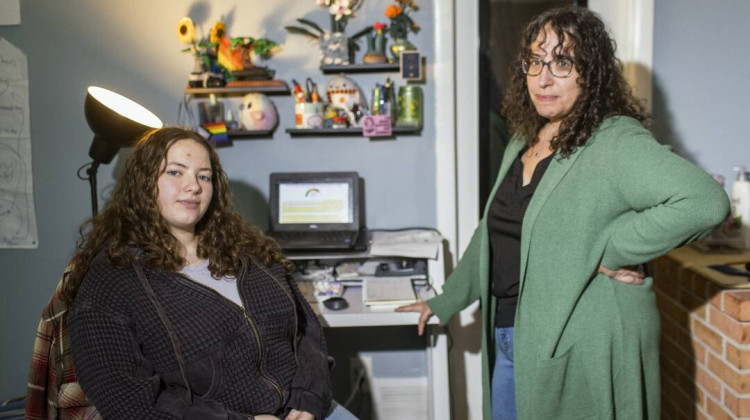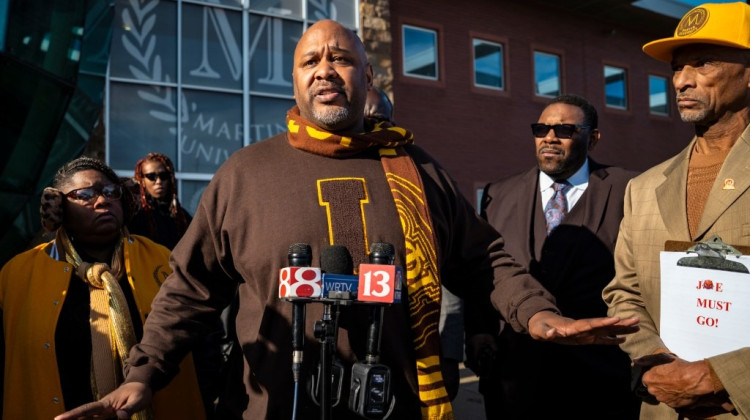On a recent morning at Chapelwood Elementary, insects chirped and rain fell lightly as the first buses arrived around 7:15 a.m. Staff lined up students on the sidewalk by grade as they came off each bus.
"We start with kindergarten. All kindergarteners get off, we are walking them all the way down to the classroom today. We have staff members that walk them all the way down trying to make sure they social distance in the hallways. Teach them hallway procedures and things like that," Assistant Principal Sean Grimes said.
Bus drivers check if students are wearing a mask and provide one if needed.
"And then when they get off the bus, if for some reason they've lost it or it's in their book bag or they can't find it, then we will have extra masks for them here at school," Grimes said.
As schools across the state settle into the realities of the new academic year, teachers and administrators are figuring out how to balance learning with health and safety.
MSD of Wayne Township, a school district on the westside of Indianapolis, opened earlier this month, with full-time, in-person instruction for preschool through 5th grade. Students in grades 6 through 12 will follow a hybrid schedule, part-time virtual and part-time in the classroom.
Students will also have the option to stay home and use the virtual-only curriculum Wayne@Home program.
As student walk single file into school and head to their home room, staff make sure students stay distanced. Masks are required for all students. Gov. Eric Holcomb issued an executive order requiring masks in schools for students in grades three and above.
"Good morning," a teacher calls out to a student. "I like your Minion mask, sir."
Brightly colored dots on the hallway floor show students how far to distance as they walk.
Principal Terri Matthews expected 700 students in grades Pre-K to 6th to be in class this month. That was around 200 students less than last year. But less than 500 students are attending regularly. The official student count for the school and district is yet to happen.

Third grade teacher Kamaren Cross, wearing a mask, greeted students to her class with quick reminders: sanitize hands and keep your mask over your nose.
"When kids come in, every time they come in from entering the room, unless leaving from the restroom, they always come in to sanitize," Cross said about the sanitize solution dispenser next to the door. "They always walk the walking path to get to their seats. Sometimes they need a little bit of reminders to do that. We also have dots that the students are standing on anytime like if they're waiting for breakfast if they're waiting for me, if we're waiting to come out of the room."
Now, they go right to their seat -- with their backpacks -- and begin to work. Breakfast is served next. After students eat, Cross and a teaching aid come around the desks and collect the trash.
When students get out of the chair -- to see Cross or go to their cubby -- they walk counter clockwise. They follow small signs that read: Be Brave. Love Yourself, Try Your Best and other positive phrases.
Students keep water bottles at their desks. Water fountains in the building are no longer available to use. Instead, students can fill up their bottles.
Cross is trying to find more ways to bring back the loose, collaborative spirit of past school years. One way is called "circle up," an idea she got from another teacher. As Cross' class begins, she asks the students to get out of their chair and sit on the desk. It's called

"Alright, go ahead and circle up. Alright, how was homework last night?," Cross asks the 19 students in the room. "Give me a thumbs up, it was in the middle, thumbs down. How’d it go?"
Sitting on the desk, Cross said, is just enough change to grab the students attention.
"It makes it feel a little bit different than our normal day of them just sitting in their chairs," Cross said. "And I feel like that makes them want to engage and they just get excited anytime I say ‘circle up’ because it's just an opportunity to change."
Last year Cross' classroom offered breakout space for students to gather and work together. Now the room feel very traditional with the desks spaced apart, by at least three feet to six feet, as recommended by American Association of Pediatrics
Cross and other Chapelwood teachers are trying to find new ways for students to interact with each other while following safety rules, like staying distanced and seated in front-facing desks.
"Because I enjoy that student interaction and kind of that partner work and them having a chance to just interact and share their work with each other," Cross said. "And so, just trying to...I've been trying to find ways to do that in a safe way. So I'm still trying to work through that."
Then there’s the noise -- actually the lack of it. Due to masks and distancing. The entire school now feels muted.
"Even having a room this quiet is really different from like previous years. Because I don't mind my students talking as long as it's on task and focused on what we're doing," Cross said. "So just trying to figure that out."
Down the hall from Cross' room, Kyrstin Brissey is taking trash bags out of the girls restroom. Brissey is the head custodian and worked at the school for more than two years.

Brissey and her team of five, are trying to keep up with the increased need, and requirement, to keep the building cleaner than it's ever been. There is the continuous cleaning in the daytime and deep sanitizing at night.
Brissey describes the pressure as feeling "crazy high."
"I could always use more people," she said.
The district purchased 5,000 gallons of sanitizing fluid for cleaning rooms and 1,000 buckets, with 450 sanitizing towels contained in each, among other personal protective equipment like face shields and disposable facemasks.
The student lunch schedule, Brissey said, was redesigned to reduce student interaction and allow the most time for custodians to clean.
"Now we're cleaning every single chair (after) every single lunch, and we have to clean the whole chair instead of just where the parts that the kids are sitting in," Brissey said about the estimated 120 chairs.
In the past, Brissey said door handles and light switches in a classroom would be cleaned regularly
"Now we are strictly focusing on all the high touch points. The fronts of hand sanitizers, the light switches door handles, even the handles on the teachers filing cabinets," she said.
The sanitizing stations in each classroom kept filled along with a bucket of clorox-type wipes.
In the past, Brissey said, she and her crew knew the entire school depended on them. Now, the stakes are much higher
"Now we have to make sure all of the children in our school are safe and we are not going to be allowing them to spread any of COVID or anything around the school," Brissey said.
Wayne Townships Schools offers students the choice to attend in-person class or remote learning.
[Top Banner Photograph] Third grade students at Chapelwood Elementary are spaced three feet to six feet apart in the classroom. They must walk in a counter clockwise path when they leave their desk. (Eric Weddle/WFYI News)
Contact WFYI education reporter Eric Weddle at eweddle@wfyi.org or call (317) 614-0470. Follow on Twitter: @ericweddle.
 DONATE
DONATE






 Support WFYI. We can't do it without you.
Support WFYI. We can't do it without you.